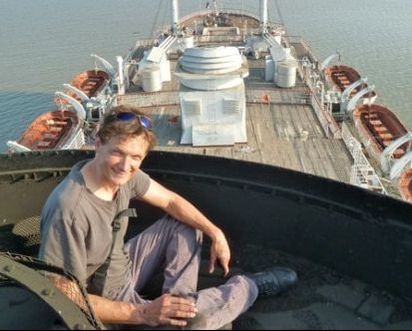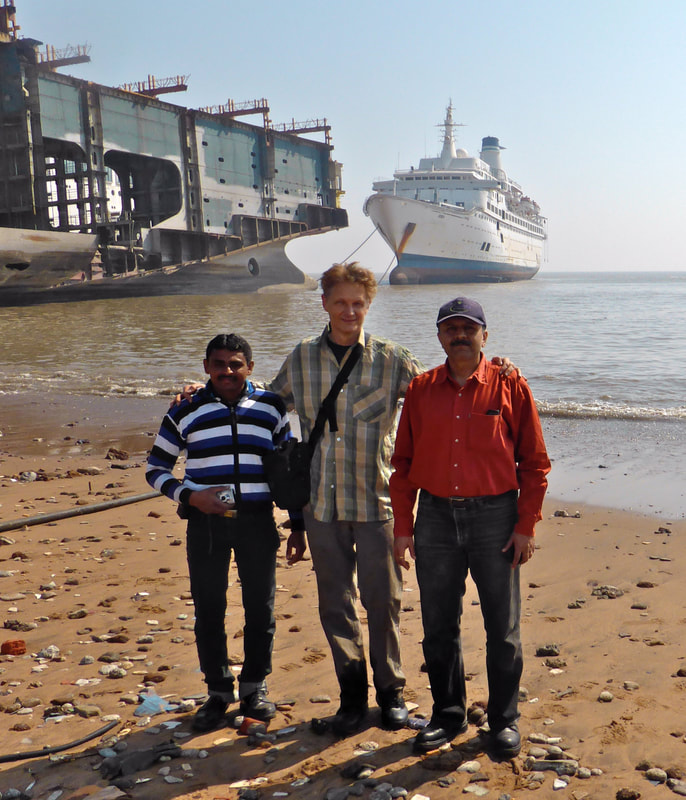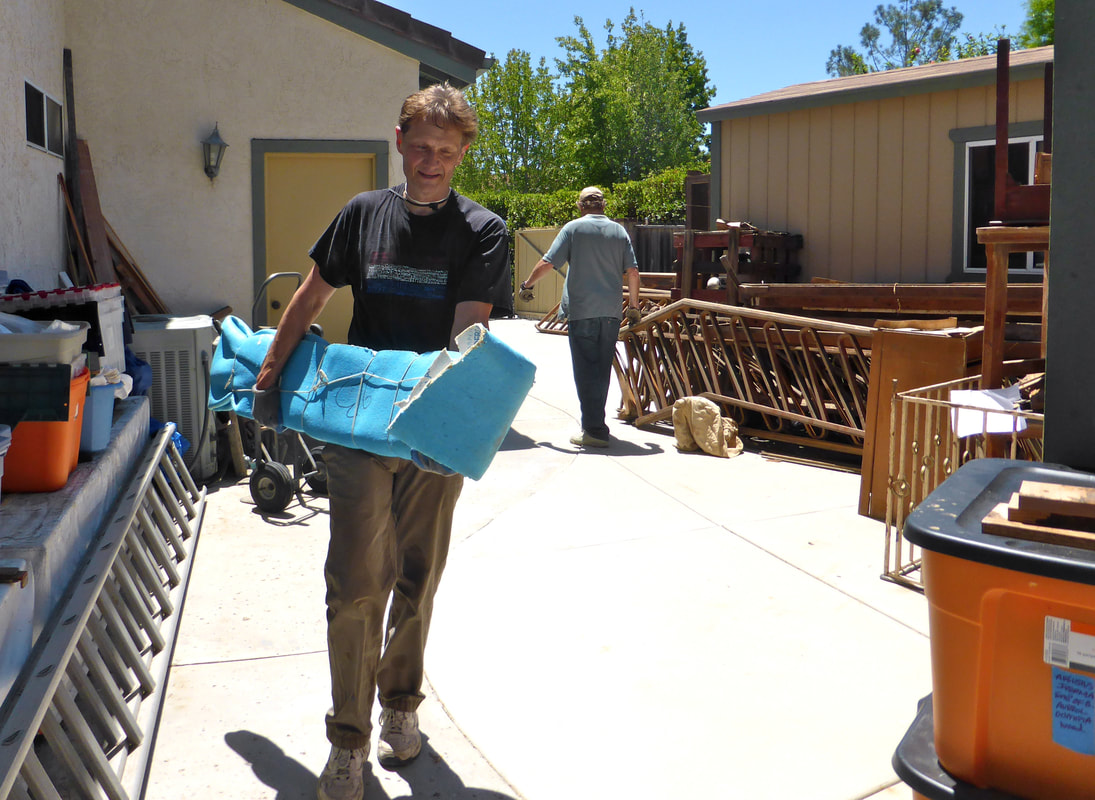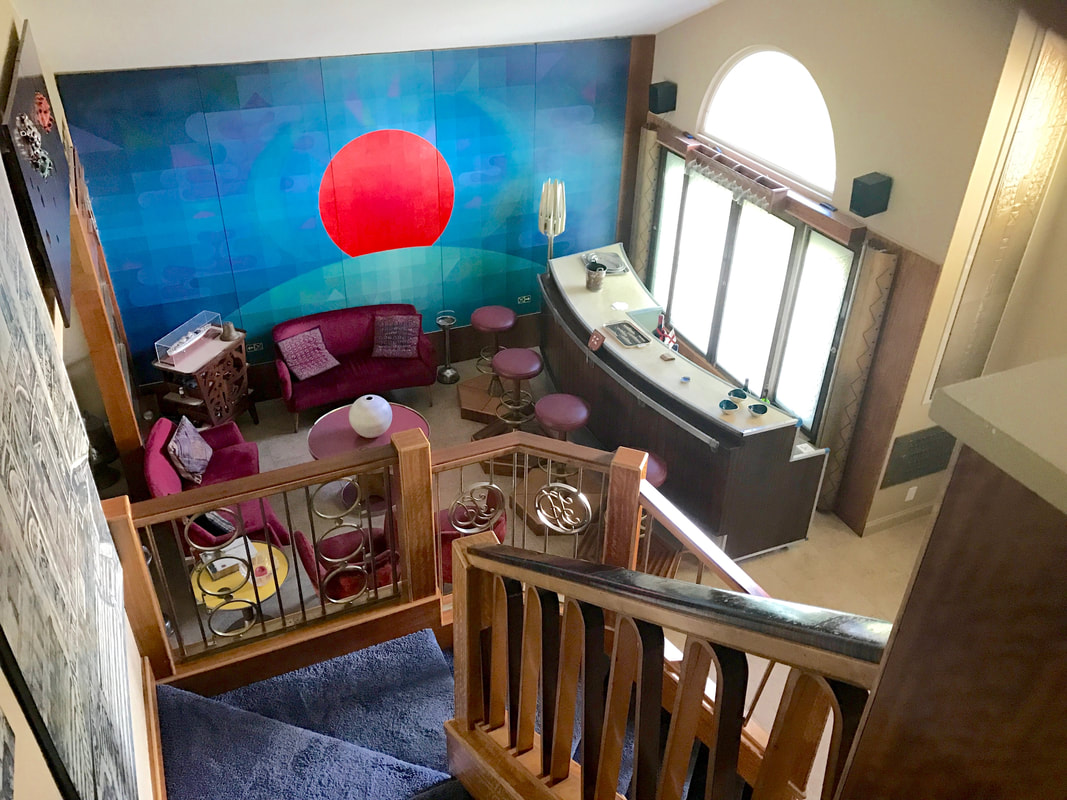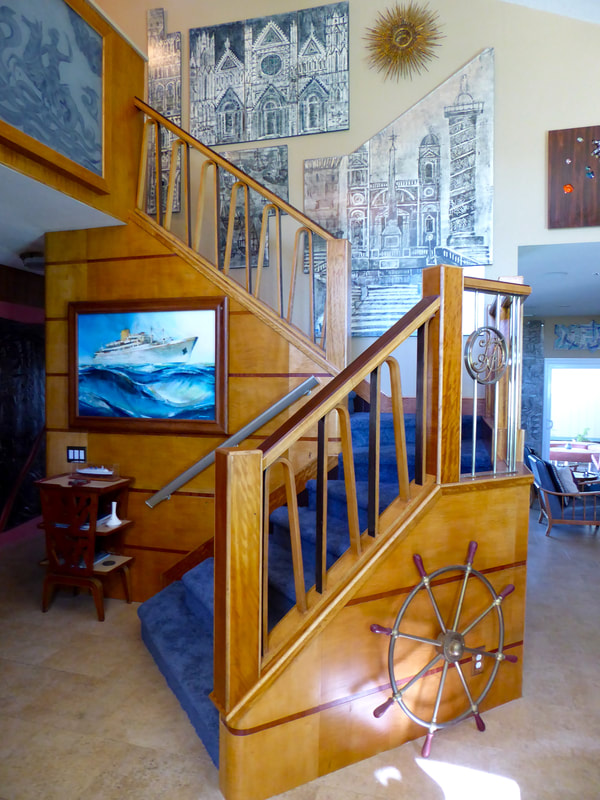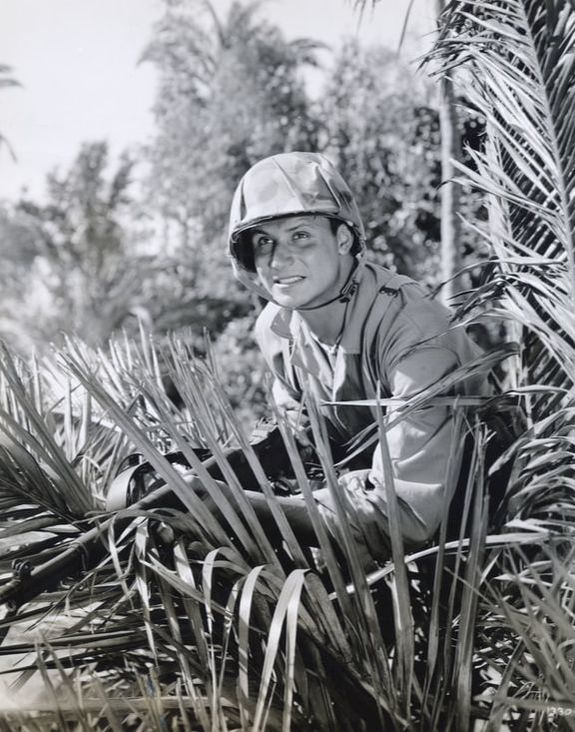Peter Knego in Alang, 2005. Behind him is the RMS WINDSOR CASTLE, onetime flagship of Union-Castle Line. Credit: Kaushai Trivedi
On a Mission to Preserve the Glory of Ships Past
Related: Meet Peter Knego (Splash Magazines)
By GERRY BARKER
North Palm Beach Life
If you want to meet Peter Knego, the best place to start is on a cruise.
Knego, a widely-acclaimed maritime historian, was among the media contingent onboard Grand Classica on her recent debut voyage from the Port of Palm Beach. Through several conversations, we learned about his dedication to chronicling and preserving the craftsmanship of classic ocean-going liners. His mission has taken him around the world, and in particular, Alang, India, a coastal town the last port of call where old ships go to die. It's a fascinating story, and one that Knego has graciously shared in the interview below.
North Palm Beach Life
If you want to meet Peter Knego, the best place to start is on a cruise.
Knego, a widely-acclaimed maritime historian, was among the media contingent onboard Grand Classica on her recent debut voyage from the Port of Palm Beach. Through several conversations, we learned about his dedication to chronicling and preserving the craftsmanship of classic ocean-going liners. His mission has taken him around the world, and in particular, Alang, India, a coastal town the last port of call where old ships go to die. It's a fascinating story, and one that Knego has graciously shared in the interview below.
|
Q. What spurred your initial interest in maritime history and how did you go about getting involved with Alang?
A. Well, my fascination with ships was due to a trio of factors that all happened in more or less the same time frame. I had always thought ships were cool, but when I was assigned to do a paper in American History class on the LUSITANIA, I was stunned to learn a four-funneled ocean liner sank with a huge loss of lives only a few years after the TITANIC. I had no idea there were other such ships, so my interest was piqued. And then the movie Poseidon Adventure came out! I loved the idea of this fabulous cast thrown into an epic ocean liner disaster. With the QUEEN MARY only an hour drive away, I was so lucky to have the actual “set" of the POSEIDON in my own back yard. The clincher was discovering John Maxtone-Graham’s magnificent book about ocean liners, “The Only Way To Cross”, which is considered the bible of ocean liner tomes. Sadly, at that time, ocean liners were dying off in rapid succession, sailing to the shipbreakers in Taiwan, so I made it a point to visit and document all passenger ships that came to Los Angeles (and when, I could get to them, in San Francisco and San Diego, too), knowing that one day, they, too would be gone. I did this for decades and then when I had the means, embarked on trips to the far corners of the earth to sail in or find in some forlorn harbor the last liners and vintage cruise ships. I managed these travels while I was working in the music business, spending months reaching out to various contacts and planning how to access a variety of locales, from the Ukraine to the backwaters of Greece, China, Japan and basically any place that had an old liner laying around. It was quite an adventure and it also made me aware of what was still on these old, beautiful ships. So when they all started sailing off to Alang in the later 90’s and early 00’s, I decided it was time for me to try and salvage what I could. One liner in particular, a gorgeous old former British ship called the AUREOL that used to sail to West Africa, prompted me to reach out to the shipbreaker and fill up a container with furniture, artwork, fittings and navigation equipment. When that first container arrived at my home, it all looked dreadful, but after cleaning up each item, my friends became intrigued and asked if I were to do it again, could I get them a chair or a table or two. MidShipCentury.com was then born and my expanded goal was to save key items for myself and to sell the extras to friends, ship enthusiasts and interior designers to cover the costs of what I was doing. In 2004, a perfect storm of liners and cruise ships had arrived in Alang all at the same time, so I decided to go there myself and not only try to document them but also get as many things as I could. That trip is pretty well covered in the first video I made about Alang called “On The Road To Alang”. Q. Alang seems somewhat tightly regulated -- like restrictions on photography and access to the ships. Can you talk about why and outline the process you went through of making the right connections. A. I cannot reveal all of my secrets about getting into Alang, which is deemed a forbidden zone to journalists and foreigners because of the pollution and work-related issues associated with ship breaking. It really isn’t much worse than most industrial situations in developing nations like India, where toxins run rampant and workers don’t receive proper protections, but Alang and similar places in Pakistan, Bangladesh and Turkey have come under much fire by groups like Greenpeace, much to the embarrassment of the respective governments. You are required to get a permit to visit these places and even then, photography is forbidden. If you make a formal request, it will never be granted and then they are aware that you are coming, so the best way is to let my contacts there handle it for me. The breakers allow them to get me past the security as they know I will be purchasing materials. As for my photography, I have to obey my friends when they tell me to put away the cameras or not take photos of certain things. I have been very fortunate to not have been caught, although there was one time when a policeman spotted me and was going to the local station to get some back up to have me removed. Had we not persuaded him otherwise with a little “baksheesh,” my cameras and film would have been confiscated, I would have been thrown out of the country and my friends would have faced some dire penalties. As I care deeply about the environment and human rights, it is a challenging situation for me but I have to accept that my mission is to salvage and document what I can of the ships themselves and not put my friends' livelihoods in danger. I’m happy to say that over the years, the working and pollution conditions have improved significantly, although they are probably still not quite up to Western standards. And yet, were it not for the greedy Western shipowners who choose to sell their ships for scrap versus paying a yard to do the demolition in an environmentally friendly way, we wouldn’t have the dilemma in the first place. Q. Take us through what's involved in selecting/purchasing salvaged items, getting them crated and shipped and then delivered to your home in California. How do the Indians determine what to charge? Can you haggle? A. From my decades of gathering information about almost every liner of the latter half of the 20th Century, I know where and when each ship was built, who designed it, the artists and artisans that were involved, etc. I can pick out the genuine treasures from the cheaper fittings and art that were added later in the ships’ careers, most likely when they were sailing for a second rate company on budget cruise or ferry service. As I have documented almost all of the passenger ships that have gone to Alang in the past 20 years, I know what to have my contacts look for in terms of furniture and art. If I can go, myself, I board the ship with them and point out all that is of interest before it gets removed. Otherwise, they go on board and take photos and then I review all the images and make them a list of what needs to be saved. There is quite a bit of haggling and some of the breakers are downright crooked. They will bait and switch, raise prices after making a deal, you name it. It can become a very frustrating process and sometimes I have to just walk away from a deal when things get out of hand. I always pay more than the locals, who are often looking for used furnishings for a hotel or restaurant. They don’t care about the provenance or history, so if the price is not right for them, they move on to the next vendor until they find what they need. Once my contacts take delivery of the items, they pack and crate them and when there is enough to fill a 40-foot container, they have it sent to me in California, where I haggle with customs (who almost always want to take the entire container full of contents out and examine each item, then repack it). I have to pay them for their efforts and if something gets broken in the process, well, too bad! Finally, when the container is released, it is driven to my home, where I have friends and workers who help me unload it in a daunting but exciting process. Most of the things go into my back yard where I uncrate them, clean them up, photograph and measure, then either incorporate them into my collection or put them on MidShipCentury.com to sell. Lately, I have been using my MidShipCentury Facebook page to sell things as the site requires a lot of extra work and the services of a friend who is not always available to get the items posted right away as I am somewhat of a Luddite when it comes to computers and websites. Q. Is there a lot of competition for what is salvaged? Do you find yourself in bidding wars or how many people like yourself are active in preserving these nautical treasures? A. There have been a couple people who have seen what I have done and tried to do the same thing. One guy even attempted to make a video of his efforts but it never saw the light of day. It made things difficult and rather expensive for me to have someone else bidding on the same things but in the end, both entities didn’t know the difference between the true treasures and the lesser things and both ended up going belly up. It is not an easy business, even when you know all of the pitfalls, so caveat emptor to anyone who thinks otherwise. There are trader yards near the breakers that sell items from the ships. When I visit those yards in person, I am told by my contact there that I am paying up to five times what a local would, but sometimes there are important things that are worth paying extra for. Q.. What did your neighbors think when the container trucks show up? A. Most of my containers were delivered to my former residence in Moorpark, north of Los Angeles. My neighbors were rather aloof and pretended to not “see” the piles of furniture being offloaded onto my lawn, but I would occasionally get the incredulous or disparaging glance. I pity them for not being savvy enough to see that even though these things were dusty and dirty that they were nonetheless special. The craftsmanship and materials, the style and scope of many of these items made/makes them very unique. Of course, now with the MidCentury design craze and television shows like “MadMen”, the efforts have been vindicated. Q. You pay tribute to your parents on the DVDs. Talk about them and the impact they had/have on your life. A. Well, thank you for noticing them. I wish I were a fraction as interesting as my parents were/are. My father was an actor named Peter Coe. He made over 50 movies and countless television appearances and was quite a character -- not an ideal dad but we overcame that and became close friends when my interest in ships began. He would take me to the harbor to visit ships when I was too young to drive. I named the Alang videos for two of his more well-known films. “On The Road To Alang” is sort of named for “The Road To Bali,” a film he did with Hope, Crosby and Lamour and “The Sands Of Alang” is sort of a tribute in name only to “The Sands Of Iwo Jima,” a John Wayne film my dad had a notable part in. If you Google “Peter Coe actor”, you can find all sorts of links to him and his work. My mother, Rosalee Calvert, on the other hand, was and is a stunning lady. She was a high fashion model (with the bone structure of Greta Garbo and style of Grace Kelly) and an angel of a mother who has encouraged me in every aspect of life. She is now 91 and doing pretty well, considering. A true beauty, inside and out. Q. In the future, when today's cruise ships are headed for Alang, will there be those same kind of priceless art and fixtures to rescue? A. Today’s ships are conceived and built in a very different way from the liners and cruise ships of the post-war era. Those ships were usually one-offs, designed by architects who cherished form as much as function. The Italians, especially, were noted for adding curves and fins, sweeping lines and flourishes to the look of a ship. If it cost a cabin or two to have that extra curvature to make the ship look powerful and dynamic, so be it. Today, ships have foreshortened bows, few curves, stacked up sterns, rows of balconies, and piled on decks that make them more cost-efficient but not so easy on the eyes. And their interiors are generally designed with lightweight, fireproof materials and artwork and furniture that are picked from catalogues or “shopped” from manufacturers. Fifty years ago, wood was still being used, there were still craftsmen who could make things by hand and artists were employed to design murals and works that represented each ship, its origins, its destinations, etc. For instance, for ships that cruised the Greek Islands, artworks depicted scenes from Homer, the pantheon of Greek Gods, ancient sites, etc. Today, with a few exceptions, the artwork tends to be generic. If it is pretty or the color matches, then it hangs here or there. There is little connection with the places the ship visits or the nation it represents, etc. So, it is unlikely that I will be chasing down today’s ships in 30 years, should I even still be here. Q. Lastly, if you could only sail on ship from the past, which one would it be, and why? A. I wouldn’t say she is my very favorite ship, but how could I not choose the NORMANDIE as the one ship to experience? In terms of scale and design, she was the ultimate. A ship of superlatives, an Art Deco palace filled with stunning artwork, the most glamorous people, legendary service and the very finest cuisine. Her life was tragically short but no other ship has lived up to her level of repute. "It is not an easy business, even when you know all of the pitfalls, so caveat emptor to anyone who thinks otherwise."
|
About Peter KnegoBorn in Los Angeles. While obtaining his degree in Theater Arts at UCLA, Peter took his first “serious” cruises, beginning in 1980 with American Hawaii’s newly-rechristened SS OCEANIC INDEPENDENCE. His travels include trips to all seven continents on board or in search of passenger ships and visits to Alang, India on eight different occasions (thus far) to witness the dismantling of many important liners. Knego travels the world on a regular basis and has contributed countless photographs and articles to USA TODAY’s Cruise Log, TRAVEL AGE WEST, TRAVEL WEEKLY, OCEAN AND CRUISE NEWS, CRUISE TRAVEL and PORTHOLE magazines as well as U.K.-based SHIPS MONTHLY and SEA LINES.
Peter’s Oceanside, CA home is a virtual museum and gallery of precious MidCentury ocean liner fittings, art and furniture and his collection has been featured in THE NEW YORK TIMES, the DAILY NEWS and LOS ANGELES MAGAZINE. He is frequently a guest “expert” on television and radio, as well as lecturer on various cruise ships. He has been quoted in many publications, ranging from THE NEW YORK TIMES and USA TODAY to a wide variety of maritime industry trades such as SEA TRADE INSIDER, TRADEWINDS and more. Peter's Website
www.midshipcentury.com for the ocean liner/cruise ship artifacts, DVDs and more. There are menus to click for ship histories, the “shop”, the videos, etc.
Photos Courtesy of Peter Knego |
Tour His Home ....

Knego’s Oceanside dining room featuring the following fittings, from left to right: Ceramic relief from Incres Lines VICTORIA of 1959, Etched glass mirror from SS EMPRESS OF CANADA of 1961, marquetry paneling from RMS EMPRESS OF BRITAIN of 1956, nickel and frosted glass chandelier from RMMV AUREOL of 1951; quilted maple, zebrine and tiger maple paneling from MV VICTORIA of 1953 and SS OLYMPIA of 1953, dining chairs from SS PROVENCE of 1951 and RMMV AUREOL of 1951, dining/serving tables from RMS IVERNIA of 1955, textured gesso painting entitled “Hunting Scene From Ancient Egypt” by Giovanni Majoli from SS AUSONIA of 1958.
Meet His Parents ...
|
|
Comments"Peter -- I am just in awe on all your works in covering the passenger ships of our past. I share your interests with passion which began at age 12.
"We migrated from the Netherlands on the ss Waterman a converted Victory ship. Although austere in design and fittings it sparked interest. Our journey became documented with a program in the Netherlands titled Andere Tijden "'Emiegreren met hinderissen.' I am seen standing with my Mother and Sister pointing out towards the rock of Gibraltar. My uncle served on the Johan van Oldenbarnaveld. "I always treasured visiting this ship when she berthed in Sydney during the early sixties before she was sold and became the ill-fated Lakonia. I thank you for your documentaries and purchasing these priceless articles, so we can continue admiring an architecture long gone. My kindest gratitude and regards. -- J.M. ----------------------------------------- "What a wonderfully interesting interview of a most fascinating man. Thank you so much for the well rounded picture you paint." --M.G.B. |
